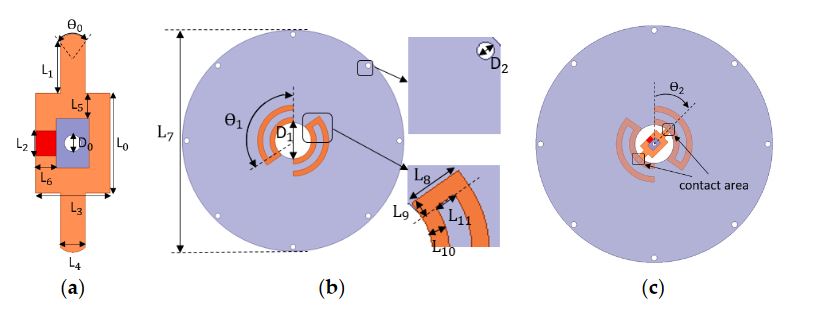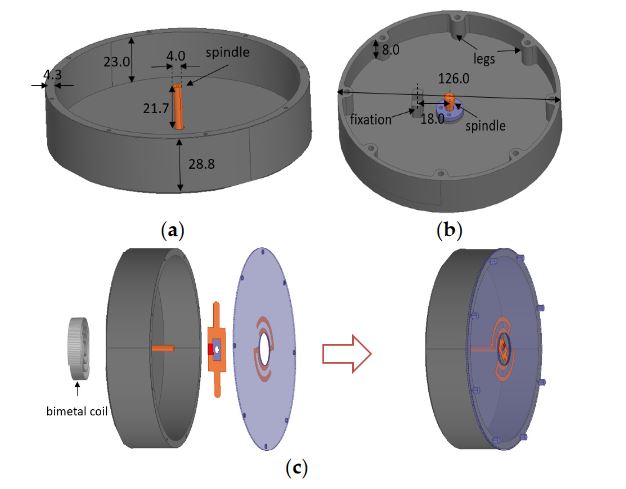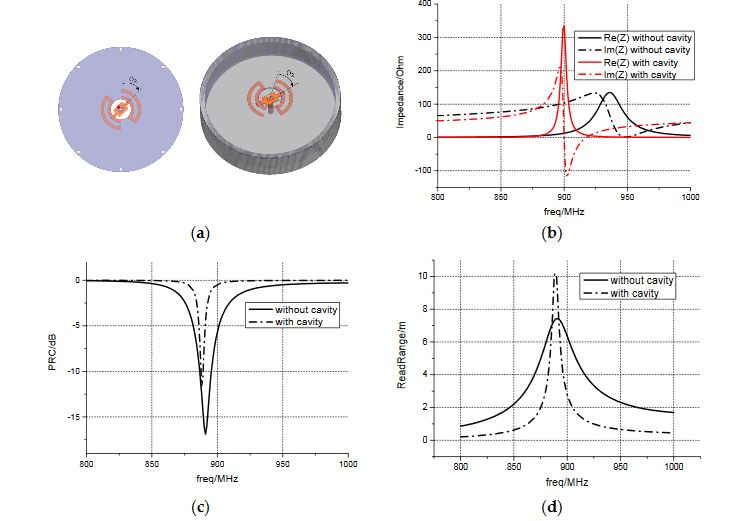ABSTRACT
A passive temperature-sensing antenna is presented in this paper, which consists of a meandering dipole, a bimetal strip and a back cavity. The meandering dipole is divided into two parts: the lower feeding part and the upper radiating part, which maintain electric contact during operation. As a sensing component, a bimetal strip coil offers a twisting force to rotate the lower feeding part of the antenna when the temperature varies.
As a result, the effective length of the dipole antenna changes, leading to a shift of the resonant frequency. Furthermore, a metal back cavity is added to increase the antenna’s quality factor Q, which results in a high-sensitivity design. An antenna prototype is designed, fabricated, and measured, which achieves a sensitivity larger than 4.00 MHz/◦C in a temperature range from 30◦C to 50◦C and a read range longer than 4 m. Good agreement between the simulation and measurement results is obtained.
DESIGN METHODS

Figure 2. Configuration of the dipole antenna: (a) Geometry of the lower feeding part; (b) Geometry of the upper radiating part
A dipole antenna includes two parts, the lower feeding part (Figure 2a) and the upper radiating part (Figure 2b). Both parts are designed on a RF-60A-0500 substrate with a dielectric constant (εr) of 6.15, a loss tangent of 0.0038, and a thickness of 1.27 mm. The lower part is a feeding loop with a RFID chip. The upper part consists of two curving U-sh ape arms which are symmetrical relative to the center point of the circular substrate.

Figure 3. Geometry of the back cavity. (a) The 3-D view of the cavity; (b) The back view of the cavity; (c) The assembly schematic diagram of the proposed antenna. All dimensions are in millimeters
Figure 3c describes the assembly procedure of the bimetal strip coil, the back cavity and the dipole antenna. One end of the bimetal strip coil is soldered to the fixation and the other is fixed to the spindle. The lower feeding part of the dipole is connected to the other end of the spindle with a screw, and the upper radiating part is fixed to the side wall of the cavity with screws.
ANTENNA SIMULATION RESULTS

Figure 4. (a) The dipole antenna without cavity (left) and the dipole antenna with cavity (right)
The antenna is simulated using ANSYS HFSS which is a commercial finite element method (FEM) solver for electromagnetic structure from ANSYS, Inc. (Canonsburg, PA, USA). Without loss of generality, the rotation angle is set to be 40◦, and the other rotation angles will be discussed in following sections. The performance comparison between the dipole antenna alone and the dipole antenna with back cavity is given in Figure 4.
ANTENNA PROTOTYPES AND MEASUREMENT

Figure 6. (a) The lower feeding part; (b) The upper radiating part; (c) The cavity
Prototypes of all components of the proposed antenna, including the lower feeding part, the upper radiating part, and the cavity, are shown in Figure 6a–c respectively. The three parts and the bimetal strip are assembled together as Figure 3c shows. Figure 6d,e show the top view and the bottom view of the cavity integrated with the lower feeding part and the bimetal coil. Figure 6f shows the prototypes of the proposed antenna in 3D view.

Figure 8. (a) The Voyantic Tagformance lite UHF RFID measurement system; (b) Measurement setup in an anechoic chamber
Figure 8a shows the photo of the Voyantic Tagformance lite. In an anechoic chamber (Figure 8b), the distance between the antenna under test and the reader is 0.5 m. Inside the reader there is an antenna with linear polarization for transmitting electromagnetic wave to, and receiving electromagnetic wave from, the sensing antenna.
CONCLUSIONS
In this paper, a high-sensitivity passive sensing antenna with a bimetal strip coil is presented for wireless temperature monitoring. The design utilizes the temperature-dependent deformation characteristic of the bimetal strip to drive the lower feeding part of the dipole rotate, thus changing the resonant frequency. A prototype is designed, fabricated and measured, and the measurement results show that the sensitivity of the proposed antenna is more than 4.00 MHz/◦C, which is the highest among the passive temperature-sensing antennas.
An approximately linear relationship between the temperature and the resonant frequency is achieved, and the read range is more than 4 m. The proposed sensor is a good candidate for large-scale wireless temperature-sensing networks such as temperature monitoring in greenhouses and livestock farms. Besides, it is noteworthy that the sensing temperature range of the antenna can be enhanced by adopting an appropriate bimetal strip coil and optimizing the dipole antenna parameters.
The imperfect metal contact between the two layers results in a large amount of power loss, which limits the read range and broadens the realized gain bandwidth. If the two parts of the antenna can operate without the requirement of mutual contact, the performance of the sensing antenna would be further improved.
Source: Tsinghua University
Authors: Xianwei Shi, Fan Yang | Shenheng Xu | Maokun Li
>> More Wireless Sensor Networks Projects Abstract for Final Year Students
>> More Diy Wireless Projects for Engineering Students